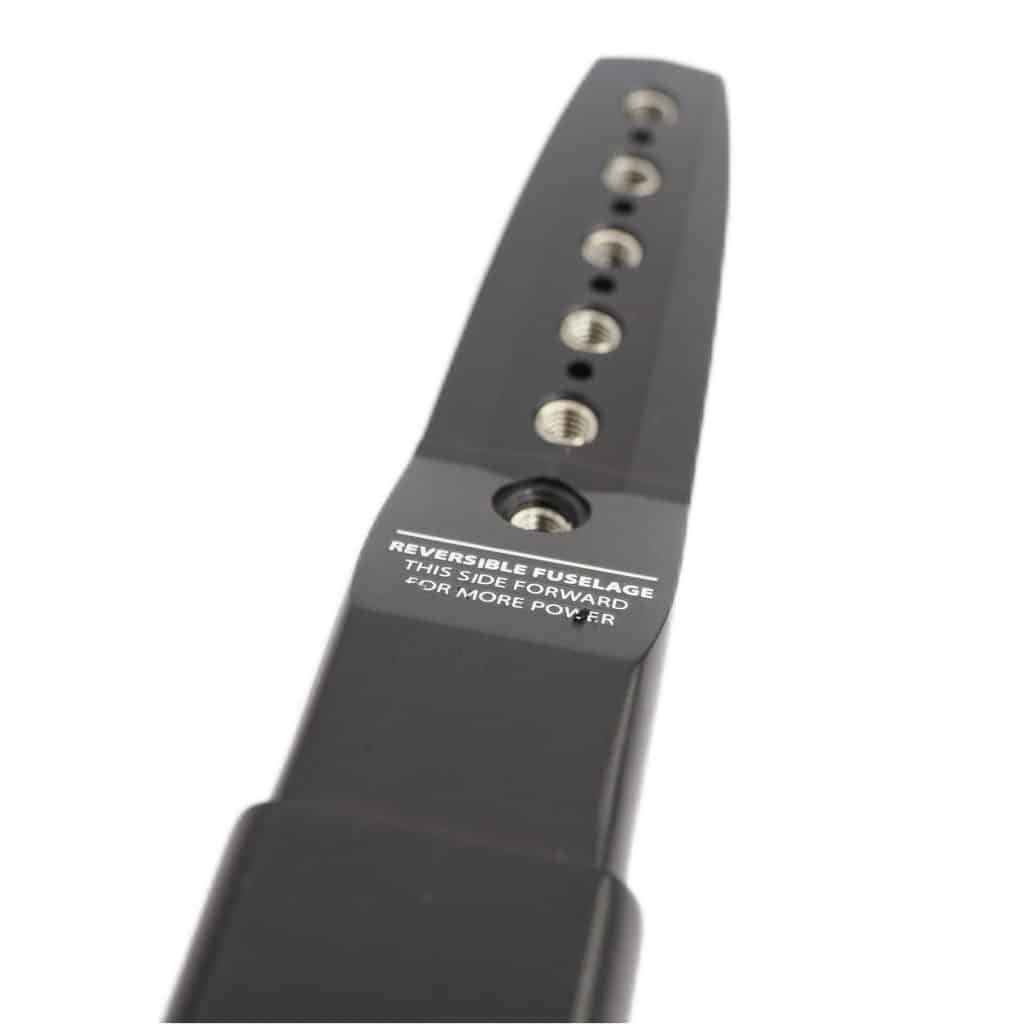Starboard introduces a new system this season: UCS (Universal Connect System). At the same time, they choose to offer fewer complete sets. Especially for racers, complete sets are no longer available, as Starboard assumes this target group prefers to assemble their own set.
We have been extensively testing different set-ups with SLX wing series for windfoiling. In this article, we share our experiences so far. Throughout the season, we will update this article with our experiences in strong wind conditions.
Trimmable Front Wings: a new addition for tuning
For the first time, you can now also adjust the angle of the front wing. This is a nice addition, but it does make tuning your set-up a bit more complex. When testing, it’s important to adjust only one component at a time. This way, you really discover the effect of a particular change. We kept track of everything in a logbook and often foiled together with regular buddies, so we could compare well.
The front wing is “the dominant wing”. By this, we mean that the front wing always wants to go straight through the water (at speed). By changing the angle of the front wing relative to the fuselage, the front wing will still go straight through the water, but the angle of the fuselage and thus also of the mast and board will change.
Ultimately, what is leading in tuning the wings is the difference in angle between the front and back wing. Therefore, we prefer to start by changing the angle of the back wing and then (if necessary) the angle of the front wing. Also keep in mind that the mast rake needs to be adjusted as well!
Extreme stiffness of the SLX wings
What immediately stands out about the SLX wings is how thin the tips are, but at the same time how extremely stiff they feel. It’s virtually impossible to bend the thin tips, which are made of C400-carbon. These wings might even be stiffer than the more expensive Patrik DNA X AEON wings.
Despite their fragile appearance, the material feels strong. With other brands, the wings are often very vulnerable. The fuselage / wing connection is also very solid and forms a very sturdy unit. The movement in the connection is clearly less than with the previous generation fuselages.
SLX Slalom windfoil set-ups
- Future Fly Flying Camel 160
- Starboard UCS 95 cm C600 Deep Tuttle mast
- Starboard UCS 99 cm fuselage
- SLX 665 front wing + SLX 160 / SLX 130
- SLX 565 front wing + SLX 130
- SLX 465 front wing + SLX 130
Starboard UCS 99 Cm fuselage can be used in 2 ways
In the past, there were 2 different fuselages in this size. Other brands often have multiple variants of windsurf fuselages where, depending on the variant, the wings are positioned further forward for more power, or further back for less power.
The UCS 99 cm fuselage has 2 variants in 1. By simply flipping the fuselage, you can choose whether you want the wings 1.5 cm more forward for more power or 1.5 cm behind the center for less power. Very clever and it works very easily.

SLX 665 / SLX 160
With light wind (about 9 to 13 knots) we start with the SLX 665 and SLX 160 with the Hyper 7 8.0m2. Because the Future Fly is very light, we choose to use the fuselage set-up for “less power”.
With just a very small gust, we get on the foil and the set feels stable immediately. It’s amazing how low the stall speed is for this set-up. We immediately notice how efficient these wings are. The foil glides “extremely nicely” through the water. However, we notice that the lift feeling on the front wing is somewhat low. With gusts, the board tends to dive downwards. After some tuning, we’ve figured it out. The back wing is set to maximum lift. This also gives us more power in the sail.
Even at speed, the foil feels stable. With a wingspan of 100 cm, the set doesn’t feel very maneuverable, but initiating a gybe is still very easy and confident. Now that we’re on the subject of gybing. We’re amazed at how low a speed we can stay on the foil. When we compare this to the Patrik AEON foil, gybing is much easier and the exit speed is significantly higher. With the Patrik AEON, we clearly need to focus more on keeping the board in the air with little wind compared to the Starboard SLX
This set-up performs best with light wind up to about 12 knots.
SLX 665 / SLX 130
By changing the back wing, the foil still gets up on the foil very quickly, but feels noticeably more dynamic and is also significantly faster. Without sacrificing too much stability and lift. We weigh around 82 kg and clearly have a preference for the setup with the SLX 130 back wing. The SLX 160 doesn’t add much for us.
SLX 565 / SLX 130
When the wind becomes more constant, say from 12 knots, we take the SLX 565 / SLX 130. This makes the set more dynamic and much faster. This setup feels neutral for a long time and is a nice combination with the 8.0m2, but also works well with the 7.0m2.
With the 7.0m2, we can trim the back wing a bit flatter, for a slightly more neutral character.
SLX 465 / SLX 130
With the 6.0 m2 and 7.0 m2 from about 16 knots, this is an even better setup. Even with this setup, the previously described character is maintained. Relatively speaking, the 465 gives a bit more lift than the 556, so we set the angle of the back wing slightly flatter for the best balance.
The foil feels “looser” and much more dynamic. Despite the small front wing, we still get on the foil very easily and the foil also glides through the jibe very easily when the wind drops momentarily.
Favorite SLX setups
| Front wing | Angle spacer* | Tail wing | Angle spacer* |
| SLX 665 | 0,75 | SLX 160 | 0,0 |
| SLX 665 | 0,75 | SLX 130 | 0,0 |
| SLX 565 | 0,75 | SLX 130 | 0,0 |
| SLX 465 | 1 (default) / 0.75 | SLX 130 | 0,0 |
*The lower the number, the greater the angle of the wing (= more lift)
Conclusion
- The SLX windfoil foil feels neutral, by adjusting the trim of the back wing, the range of use can be increased without feeling too much that the front wing is too big or too small
- With light wind, we find this foil better than the Patrik AEON foil. It’s easier to foil because the foil provides more lift during foiling, gets on the foil more easily, and maintains more lift during jibes
- With medium wind, the SLX windfoil is fairly comparable to the Patrik AEON, although the mast of the Patrik AEON is stiffer
- In strong wind and tricky conditions, for foilers who have the technical skills to really go fast, the Patrik AEON is the better choice.
- What really appeals to us is the accessibility of the SLX foil and how easy this foil is to fly, how easy the transitions are, and how quickly you get on the foil.
- We are convinced that a very large part of the “non-pro” racers will have more fun with the SLX foils than with the Patrik AEON. Simply because the low-end range is better. And in low and medium wind range, the foil goes just a bit easier at high speed.
Want to test the Starboard SLX windfoil yourself?
Do you want to test the SLX windfoil yourself? That’s possible, we have various setups available for testing. Send us an email and we’ll be happy to schedule a test appointment with you.


